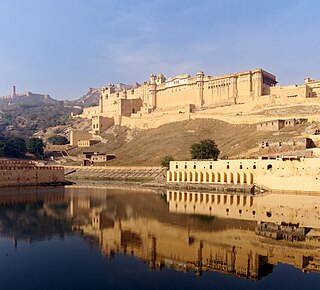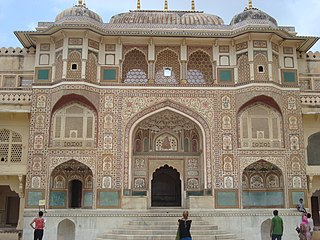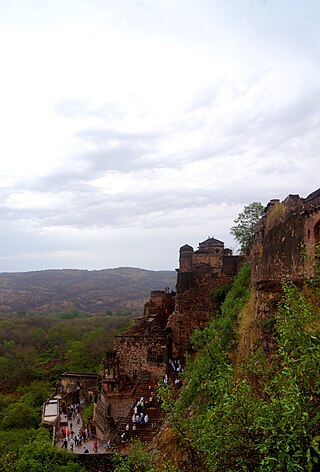
Rajasthan is a state in northwestern India. It covers 342,239 square kilometres (132,139 sq mi) or 10.4 per cent of India's total geographical area. It is the largest Indian state by area and the seventh largest by population. It is on India's northwestern side, where it comprises most of the wide and inhospitable Thar Desert and shares a border with the Pakistani provinces of Punjab to the northwest and Sindh to the west, along the Sutlej-Indus River valley. It is bordered by five other Indian states: Punjab to the north; Haryana and Uttar Pradesh to the northeast; Madhya Pradesh to the southeast; and Gujarat to the southwest. Its geographical location is 23°.3' to 30°.12' North latitude and 69°.30' to 78°.17' East longitude, with the Tropic of Cancer passing through its southernmost tip.

Jaipur is the capital and the largest city of the north-western Indian state of Rajasthan. As of 2011, the city has a population of 3.1 million, making it the tenth most populous city in the country. Located 268 km from the national capital New Delhi, Jaipur is also known as the Pink City due to the dominant color scheme of its buildings in old city.

Bhairon Singh Shekhawat was an Indian politician who served as the vice president of India. He served in that position from August 2002, when he was elected to a five-year term by the electoral college following the death of Krishan Kant, until he resigned on 21 July 2007, after losing the presidential election to Pratibha Patil. Bhairon Singh Shekhawat was a member of the Bharatiya Janata Party. He served as the Chief Minister of Rajasthan three times, from 1977 to 1980, 1990 to 1992 and 1993 to 1998. He represented several constituencies in Rajasthan Vidhan Sabha from 1952 to 2002. He was awarded Padma Bhushan in the year 2003.

Shekhawati is a region in Northern India that comprises Sikar, Jhunjhunu, and Churu.

The Hawa Mahal is a palace in the city of Jaipur, Rajasthan, India. Built from red and pink sandstone, it is on the edge of the City Palace, Jaipur, and extends to the Zenana, or women's chambers.

The Sawai Mansingh Stadium, popularly known as SMS Stadium, is a cricket stadium in Jaipur, Rajasthan, India. It was built during the reign of Sawai Man Singh II, the former Maharaja of the state of Jaipur. The stadium owned by the Government of Rajasthan and operated by RCA, having a seating capacity of about 30,000 spectators. The stadium is the home ground of Rajasthan Royals, a team in the Indian Premier League.

Amer Fort or Amber Fort is a fort located in Amer, Rajasthan, India. Amer is a town with an area of 4 square kilometres (1.5 sq mi) located 11 kilometres (6.8 mi) from Jaipur, the capital of Rajasthan. Located high on a hill, it is the principal tourist attraction in Jaipur. Amer Fort is known for its artistic style elements. With its large ramparts and series of gates and cobbled paths, the fort overlooks Maota Lake, which is the main source of water for the Amer Palace.

Sawai Madhopur is a city in the Sawai Madhopur district in the southeastern part of the Indian state of Rajasthan. It is the administrative headquarter of Sawai Madhopur District in Rajasthan.

Jaipur District is a district in the state of Rajasthan in Northern India.the city of Jaipur, which is Rajasthan's capital and the largest city, is the district headquarters. It is the tenth most populous district in India.

Sardarshahar is a city located in the Churu district of Rajasthan, India. It is also the seat of the Rajasthan legislative assembly Sardarshahar Assembly constituency. Sardarshahar is the tehsil headquarter. and part of the Churu Lok Sabha constituency. Sardarshahar was established in 1838 at the place of "Alwana" village in Bikaner state. The city is named after Sardar Singh, The son of Bikaner Maharaja(Raja Ratan Singh). It is known for its grand Havelis (mansions) with frescoes, The only Clock Tower (GhantaGhar) in Asia which streets running under it in all four directions, Shri Ichha Puran Balaji Mandir, Acharya Shri Mahapragya Samadhi Sthal(ShantiPeeth), Gandhi Vidya Mandir and many more. It is famous for its Food, handicraft work, silver work, and woodwork. It is the birthplace of the Eleventh Acharya -Acharyashri Mahashramanji of the Shri Jain Terapanthi Sect.

Ranthambore Fort lies within the Ranthambore National Park, near the city of Sawai Madhopur in Sawai Madhopur district of Rajasthan, India. The park being the former hunting grounds of the Maharajas of Jaipur until the time of India's Independence. It is a formidable fort having been a focal point of the historical developments of Rajasthan. The Ranthambhore fort is believed to have been built during the 5th century by Yadavas ruler Maharaja Jayant. The Yadavas king ruled over it until they got expelled by Prithviraj Chauhan in 12th century. The fort was occupied by Sultans of Delhi. Later on, It came under control of Marwar and Mughals.The fort provides a panoramic view of the surrounding Ranthambore National Park and is now a popular tourist attraction.
University Maharaja's College is a college in Jaipur, the capital of the Rajasthan state in India. Established in 1844 by Sawai Ram Singh II, it has been affiliated with University of Rajasthan since 1947. Maharaja college offers course on campus in Bachelor of Science (BSc) and Bachelor of Computer Application (B.C.A) at Undergraduate (U.G.) level. The college was granted the status of "college with potential excellence" by UGC in 2011.

Rajasthan, the largest state in India, is known for its rich cultural heritage, vibrant traditions, and historical significance. The Culture of Rajasthan which developed over the past millennia, is a blend of various elements, including music, dance, cuisine, festivals, art, and architecture.

The City Palace, Jaipur is a royal residence and former administrative headquarters of the rulers of the Jaipur State in Jaipur, Rajasthan. Construction started soon after the establishment of the city of Jaipur under the reign of Maharaja Sawai Jai Singh II, who moved his court to Jaipur from Amber, in 1727. Jaipur remained the capital of the kingdom until 1949—when it became the capital of the present-day Indian state of Rajasthan—with the City Palace functioning as the ceremonial and administrative seat of the Maharaja of Jaipur. The construction of the Palace was completed in 1732 and it was also the location of religious and cultural events, as well as a patron of arts, commerce, and industry. It was constructed according to the rules of vastushastra, combining elements of Mughal and Rajput architectural styles. It now houses the Maharaja Sawai Man Singh II Museum, and continues to be the home of the Jaipur royal family. The royal family has around 500 personal servants. The palace complex has several buildings, various courtyards, galleries, restaurants, and offices of the Museum Trust.The MSMS II Museum Trust is headed by chairperson Rajamata Padmini Devi of Jaipur. Princess Diya Kumari runs the Museum Trust, as its secretary and trustee. She also manages The Palace School and Maharaja Sawai Bhawani Singh School in Jaipur. She founded and runs the Princess Diya Kumari Foundation to empower underprivileged and underemployed women of Rajasthan. She is also an entrepreneur. In 2013, she was elected as Member of the Legislative Assembly of Rajasthan from the constituency of Sawai Madhopur.

The Albert Hall Museum in Jaipur is the oldest museum of the state and functions as the state museum of Rajasthan, India. The building is situated in Ram Niwas garden outside the city wall opposite New gate and is a fine example of Indo-Saracenic architecture. It is also called the Government Central Museum. It was considered one of the best 19th century museums for the variety of its collections. It was renovated in 2008 and reopened as one of the most advanced museums in India.

Diya Kumari is an Indian politician from Bharatiya Janata Party currently serving as the 6th Deputy Chief Minister of Rajasthan alongside Prem Chand Bairwa in the ministry of Bhajan Lal Sharma. She currently represents Vidhyadhar Nagar as an MLA in the 16th Rajasthan Legislative Assembly. She is a member of Kachhwaha family of the Jaipur State.

The following outline is provided as an overview of and topical guide to Rajasthan:
Sukhbir Singh Jaunapuria is an ex-member of Indian parliament, and owner of a Gurugram-based real estate group. He is a former Tonk-Sawai Madhopur member after winning the 2014 and 2019 Lok Sabha election from Tonk-Sawai Madhopur in Rajasthan as a candidate of the Bharatiya Janata Party. He defeated former member of parliament and former Indian cricket team captain Mohammad Azharuddin by a margin of 1,48,000 votes. In the recent 2019 Lok Sabha elections, he won by defeating ex-cabinet minister Namo Narayan Meena by 1,1100 votes. He was a former independent member of the Haryana Legislative Assembly in the Sohna Vidhan Sabha Constituency from 2004 to 2009. He won the Sohna seat independently by defeating political stars of the Congress Party and others.
Kirti Kumari was a member of the erstwhile Royal Family of Bijolia, daughter of present Rao Saheb Shri Chandraveer Singh ji of Bijolia and Rani Saheb Manohar Kanwar of Auwa (Marwar). She was an alumnus of the Sophia Senior Secondary School, Ajmer & later the Sophia College where she completed her Bachelor of Arts. She worked for the Mayo College Girls School as a House Master in Jamila Singh House. Next she entered politics and was a politician from the Bharatiya Janata Party and a member of the Rajasthan Legislative Assembly representing the Mandalgarh Vidhan Sabha constituency in Bhilwara district, Rajasthan. Kumari died of a swine flu infection on 28 August 2017. She was fifty years old.

Chandramani Singh was an Indian art historian, textile expert, writer and a museum archivist based in Jaipur, Rajasthan. As a writer, Singh had edited and authored numerous works on museums, culture, and heritage. Her notable works include Jaipur Rajya ka Itihas, Art Treasures of Rajasthan, Performing Arts of Rajasthan: Lok-Rang, and Protected Monuments of Rajasthan among others. She was associated with Banaras Hindu University, the Sawai Mansingh II City Palace Museum and Jawahar Kala Kendra. She had also worked for the restoration of the Jaigarh Fort, Jaipur. She died in 2022 after a prolonged illness.

















